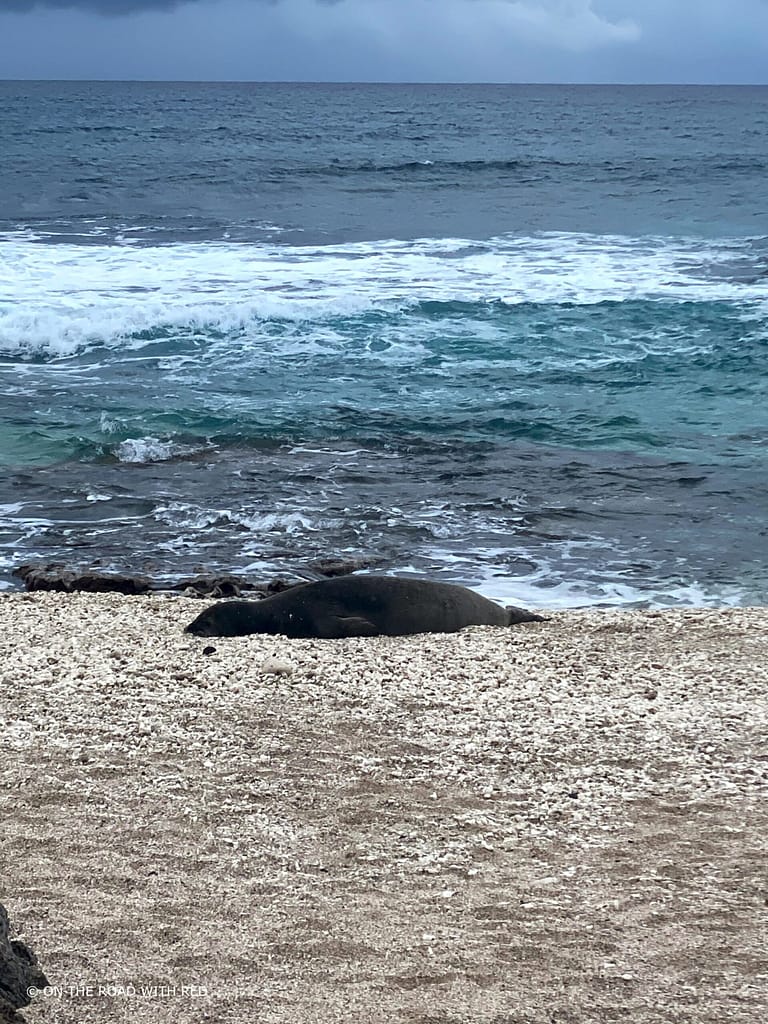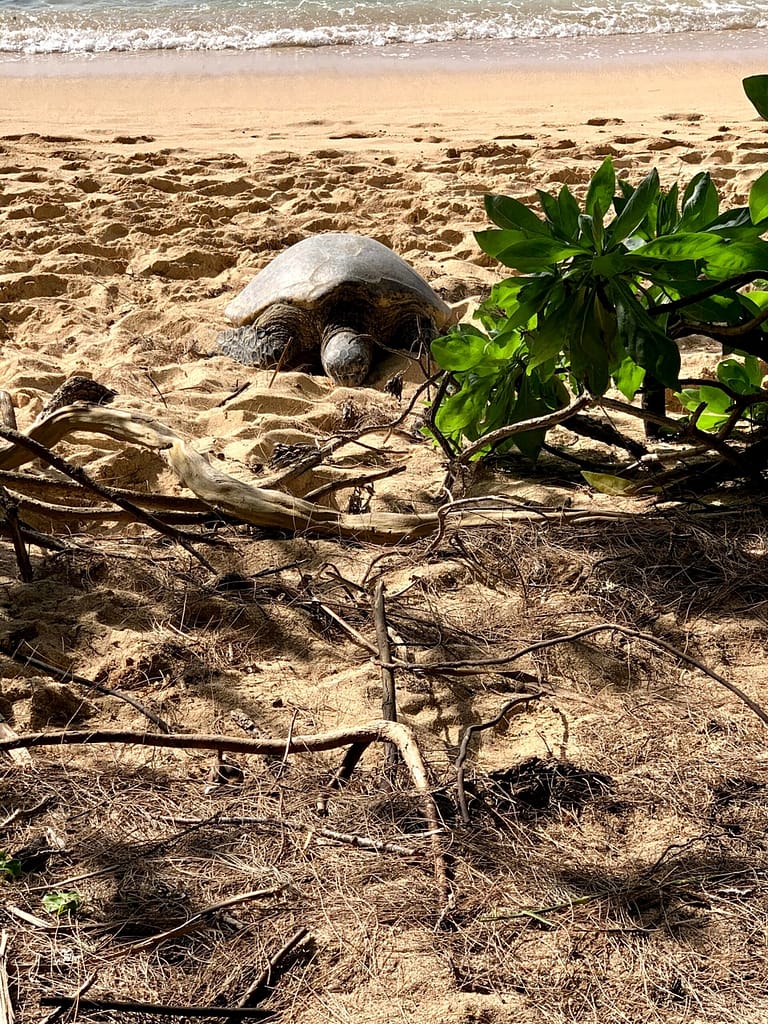Sustainable Travel With Children
Disclosure: This post may contain affiliate links. If you click through and make a purchase, we may receive a small commission at no extra cost to you. Thank you for supporting our adventures!
Exploring the World Responsibly
Sustainable Travel with Children can be a transformative experience, allowing families to bond, explore new cultures, and create lasting memories. However, it’s also essential to consider the impact of your adventures on the planet. Sustainable and minimalist travel offers an opportunity to explore the world responsibly while teaching children valuable lessons about protecting our planet’s resources. In this blog post, we’ll explore how to embark on eco-conscious journeys with your little ones, minimizing your environmental impact along the way.
Choose Eco-Friendly Accommodations
Traveling with family is an adventure filled with learning experiences and joyous memories. As we journey through various destinations, we’ve realized the importance of choosing eco-friendly accommodations. This choice is more than a trend; it’s a commitment to preserving the world for future generations.
Understanding Eco-Friendly Accommodations
Eco-friendly accommodations are more than just hotels with a recycling bin. They embody practices that reduce environmental impact. This includes using renewable energy sources, water conservation methods, and sustainable building materials. For families traveling with children, these places offer an educational aspect, teaching kids about sustainability in a practical, engaging way.
Why Choose Green Lodging
Opting for green lodging has a significant impact. It supports local communities and encourages the preservation of natural habitats. This aligns perfectly with our values at ‘On the Road with Red‘. We believe in responsible tourism where our travel choices help rather than harm the environment.
How to Find Eco-Friendly Accommodations
Finding these gems isn’t as daunting as it may seem. Start with certified eco-friendly hotels or resorts. Look for establishments with recognized environmental certifications. These often have detailed information about their sustainable practices on their websites.
- Bookdifferent: Only lists eco-certified hotels from a list of transparent and rigorous certification organizations they approve of.
- Earth Changers: A collective of sustainability-focused tourism professionals who curate international travel opportunities that benefit locals as much as possible.
- Bio Hotels: Eco-hotels in parts of Europe with a heavy focus on organic food offerings
- Farmstay Planet: Farmstays in Europe
- Responsible Travel: Responsible tour booking website that also has accommodation-only options.
- Ecobnb: B&Bs and guesthouses ranked on how many criteria points they meet
Involve the Kids in the Choice
Involving children in the decision-making process is an excellent way to instill eco-conscious values. Let them help research and pick the accommodations. This makes them feel invested in the trip and teaches them about sustainable living.
Eco-Friendly Does Not Mean Less Comfort
There’s a misconception that choosing eco-friendly means compromising on comfort. This isn’t true. Many eco-resorts and hotels offer luxurious amenities while maintaining sustainable practices. Just be on the lookout for green-washing versus actual sustainability. It’s about enjoying your vacation responsibly.
Lasting Impact of Eco-Conscious Travel
Choosing eco-friendly accommodations has a lasting impact. It teaches our children to be mindful travelers. They learn to respect and care for the environment, a lesson that goes beyond the duration of a trip.
In conclusion, as a family that values sustainable travel, choosing eco-friendly accommodations isn’t just a choice. It’s a way of life. It’s about showing our children, and children like them, that every decision we make can contribute to a healthier, more sustainable world. Let’s make our travel choices count for the betterment of our planet. As a bonus, when you choose eco-friendly accommodations the neighbors are pretty interesting.
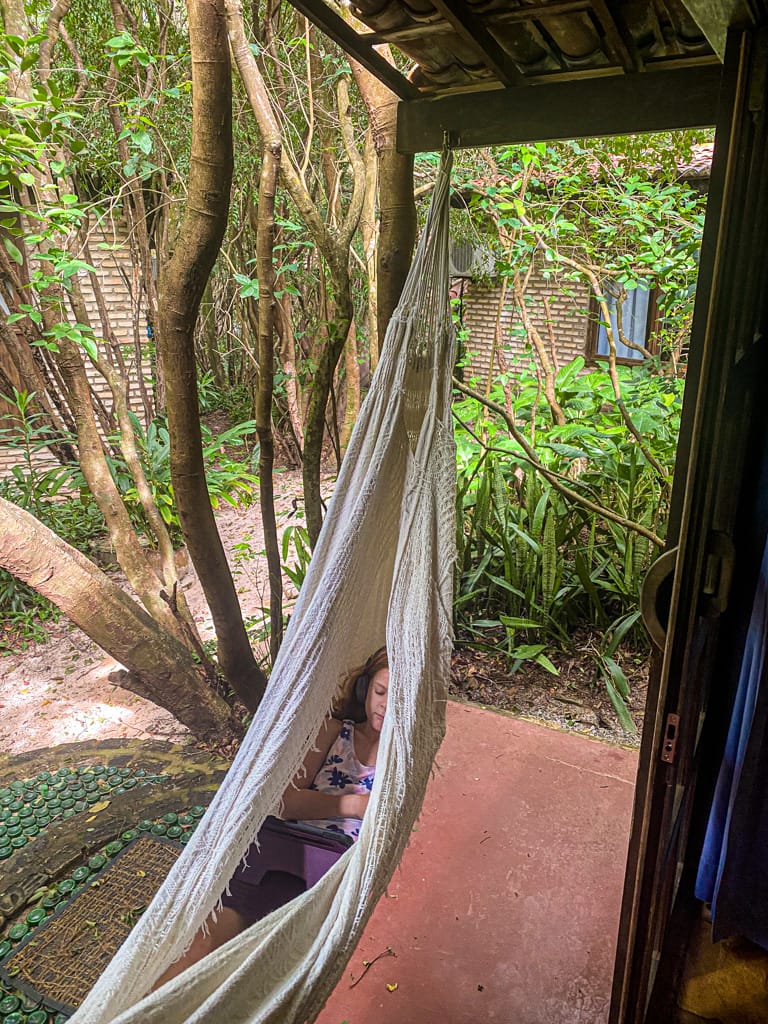

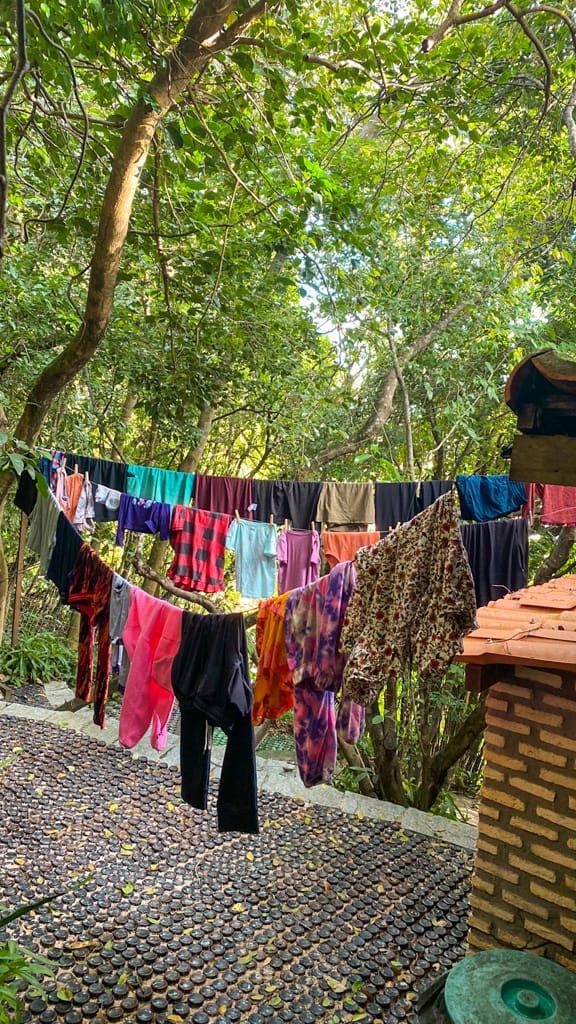
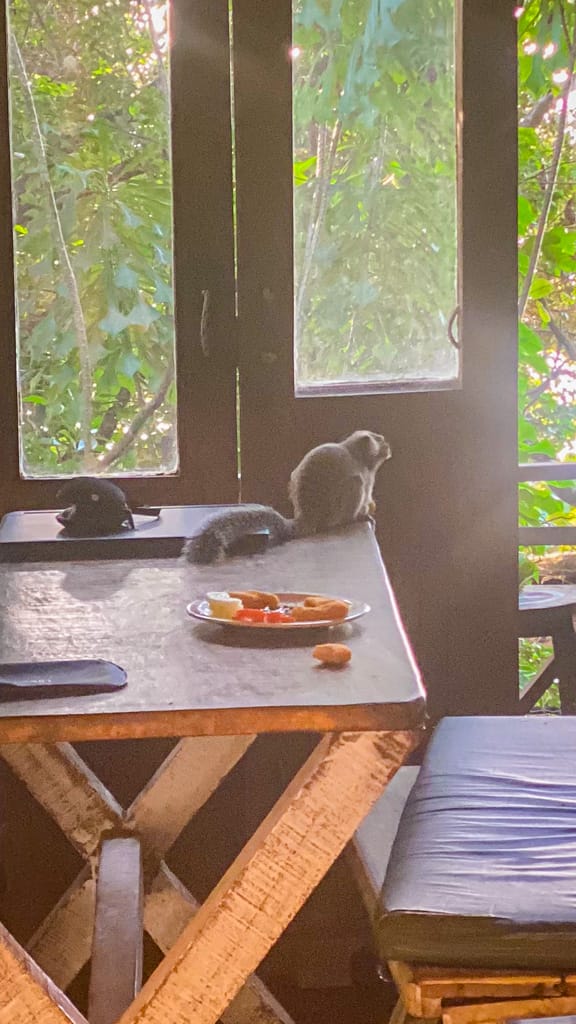
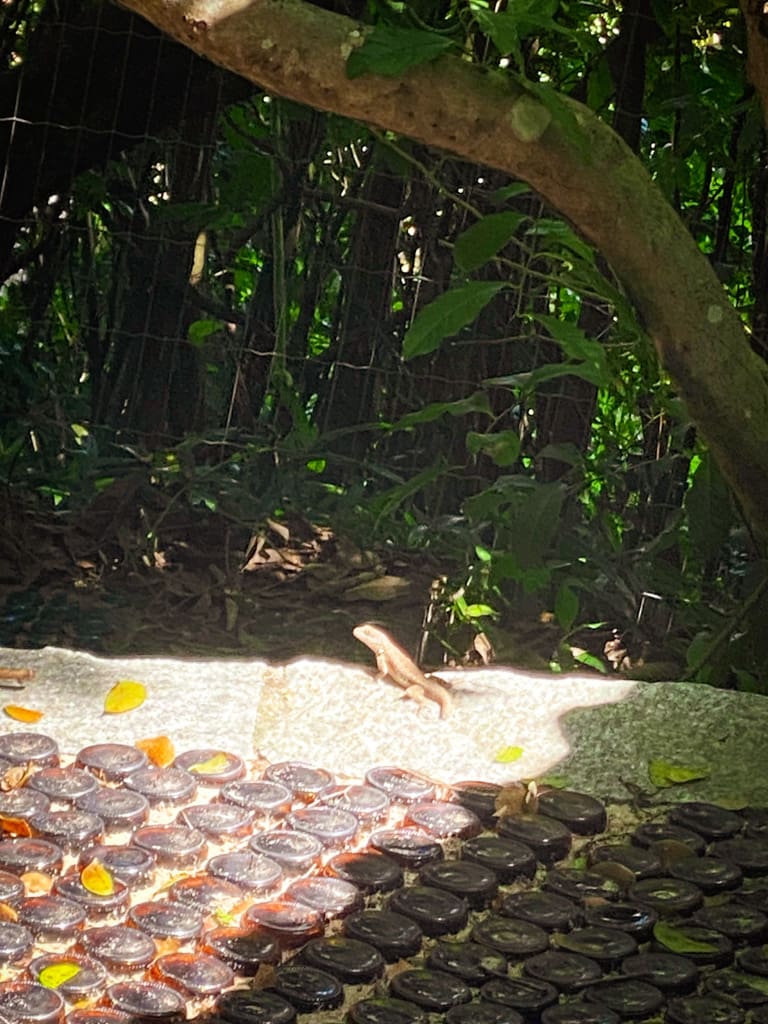
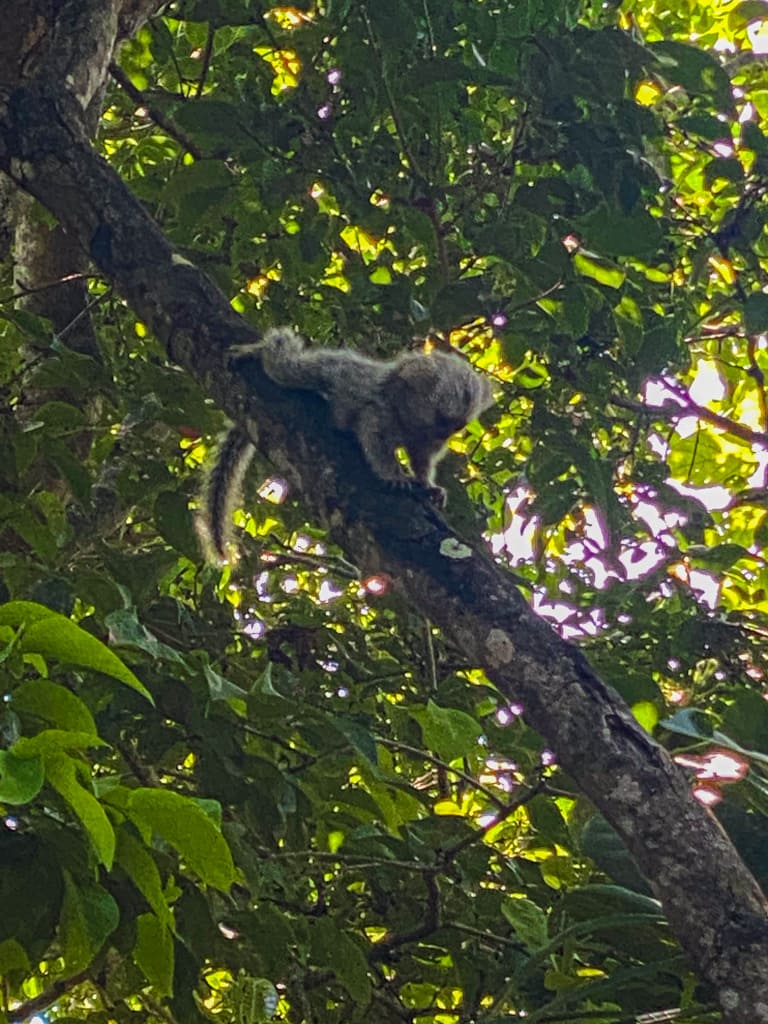
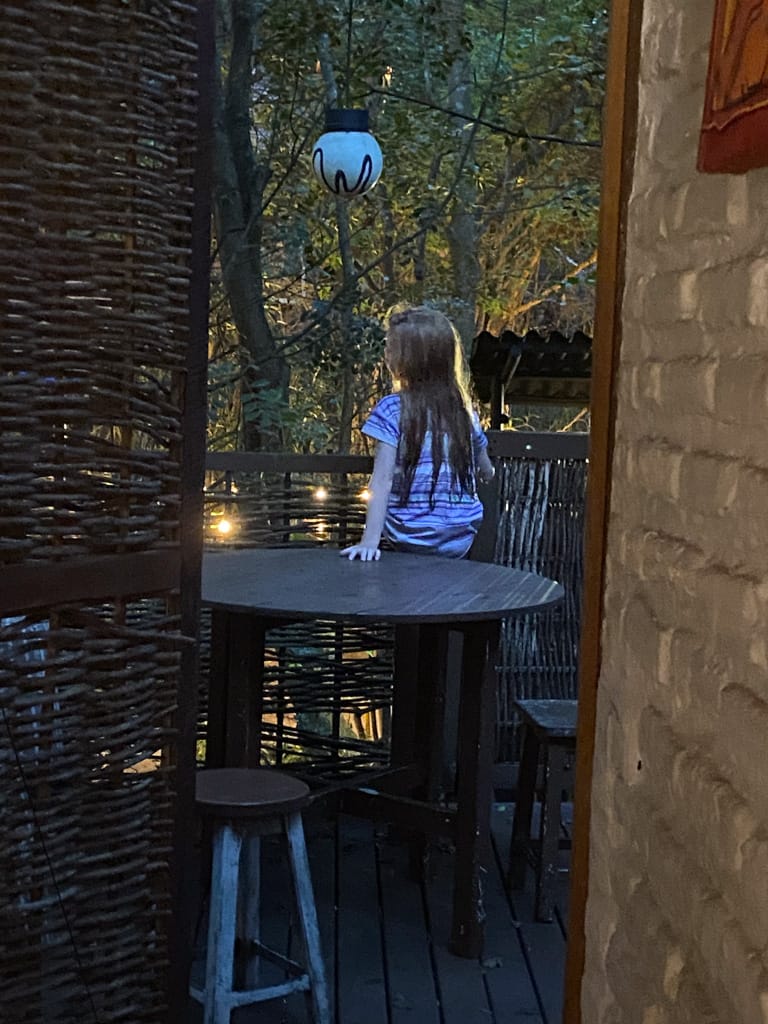
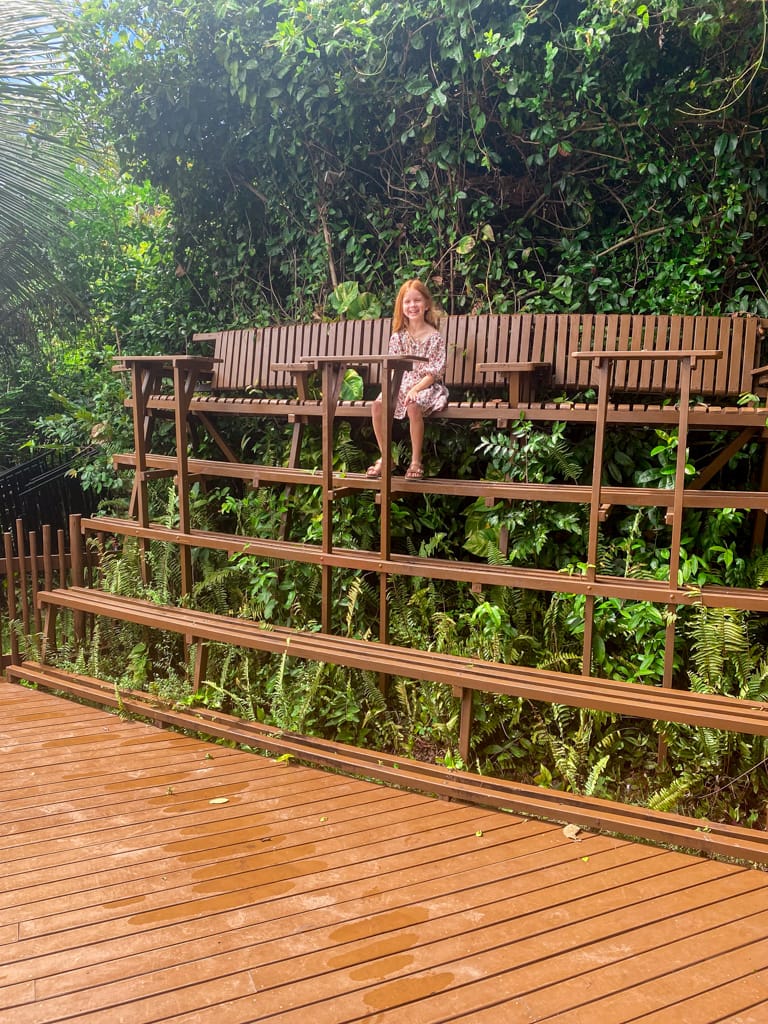
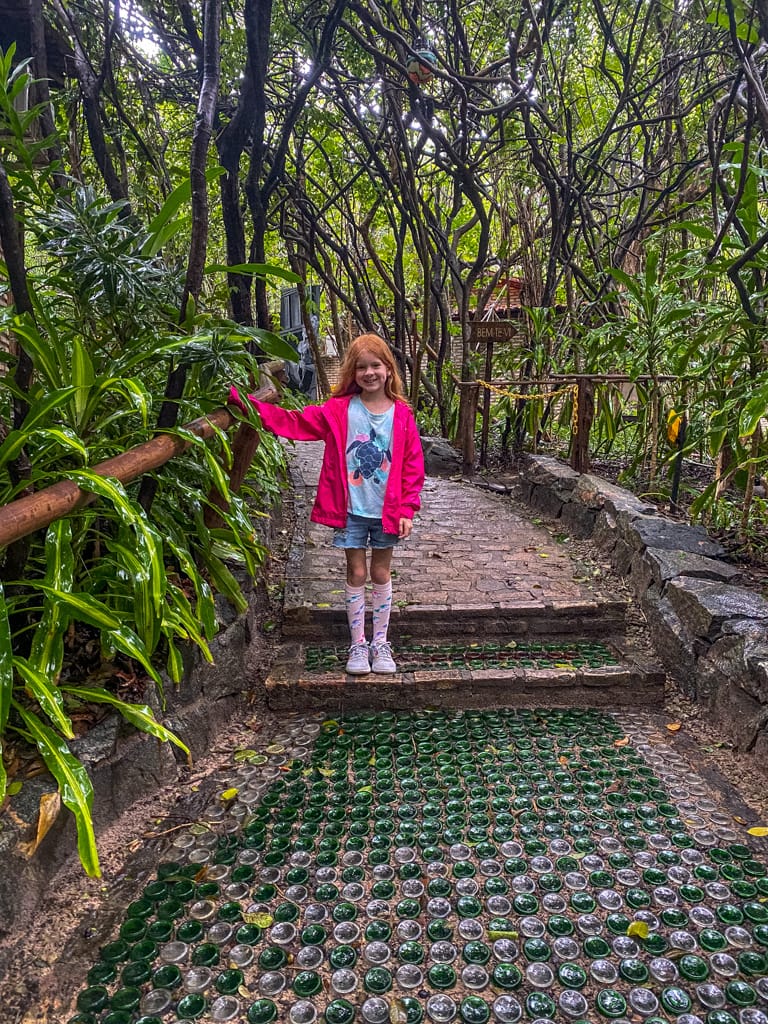
Pack Light and Smart
Traveling with children can often mean packing extra items, but it doesn’t have to mean overpacking. At “On the Road with Red,” we’ve learned that packing smart and light is not just convenient, it’s a step towards sustainable travel with children. Here’s how you can do it too.
The Philosophy Behind Light Packing
The idea of packing light goes beyond just reducing luggage weight. It’s about minimizing our environmental impact. Each extra kilogram on a flight or a car adds to fuel consumption and CO2 emissions. By packing only what’s necessary, we can reduce our carbon footprint.
Start with a Sustainable Packing List
Creating a sustainable packing list is the first step. Focus on multi-functional items and those made from sustainable materials. For instance, choose clothing that can be layered and mixed to create different outfits. Opt for eco-friendly toiletries and reusable water bottles. These are concepts I take very much to heart. When we went on the road full-time, it was with a very purposeful, very small amount of items. It has probably been one of my favorite parts of our journey.
Involve Kids in the Packing Process
Including children in the packing process is essential. Teach them to choose only what they need. This not only helps in packing light but also instills a sense of responsibility and decision-making in them. This has been a rough one for us. With a pre-pre-teen daughter (which in today’s world is pre-teen) the struggle is real. Even for the most recent 5-week trip from our current nomad base, there were negotiations involved. You don’t want children to feel they are having to give up everything. That will make them lose their appreciation of the adventure. However, it is a fantastic opportunity to reinforce the concepts of need vs. want.
Opt for Rental or Borrowing Options
When it comes to items like strollers, car seats, or even certain types of clothing, consider rental options at your destination. This approach reduces luggage and supports the sharing economy. Expat pages are a great resource for things like this.
Use Sustainable Luggage Options
Invest in durable, eco-friendly luggage. Many brands now offer suitcases and travel bags made from recycled materials. These are not just sustainable but also tend to be more durable.
The Benefits of Packing Light
Packing light has numerous benefits. It makes traveling more manageable, especially when juggling kids and their needs. It also reduces stress and saves time, making the travel experience more enjoyable for everyone.
Smart and light packing is an achievable and important aspect of sustainable travel with children. It’s not just about making your travel easier; it’s about making a positive impact on the environment. By teaching our kids to travel sustainably, we’re nurturing a new generation of conscious travelers.
Packing List
Below are pictures of how we packed for a 5-week trip through 3 locations in Patagonia. Not pictured are electronics, 3 headlamps, and toiletries. This is for Patagonia during the summer, but when you travel almost to Antarctica it is still cold. This is all of our winter gear. I cannot stress layers and merino wool enough. The pictures include our Patagonia and Arc’teryx packable jackets. Absolute game changers.
The three smaller backpacks are what we use for personal items for flights, as well as daily backpacks. The black Pacsafe is a must-have for anyone who travels. We have the Pacsafe ECO 25L Anti Theft Backpack. We use this backpack daily. It is surprisingly spacious and light. The security features are amazing. We are alert travelers but extra security is not a bad thing.
Aside from what you see in the picture, the only other “luggage” we have is a cheap duffel bag purchased in the US at Ross and a 2nd Osprey 40L backpack. The Fairview is made to be more comfortable for women. Rob has a Farpoint 40L. This also shows how truly minimalist we are. Our larger Osprey pack is the Osprey Farpoint Men’s -Wheeled Travel -Pack 65L. I would change nothing about our choices for luggage. They are light, sustainable, collapse when not in use and high quality. All of our Osprey packs also have backpack straps that can be stored. Perfect for stowing on planes.
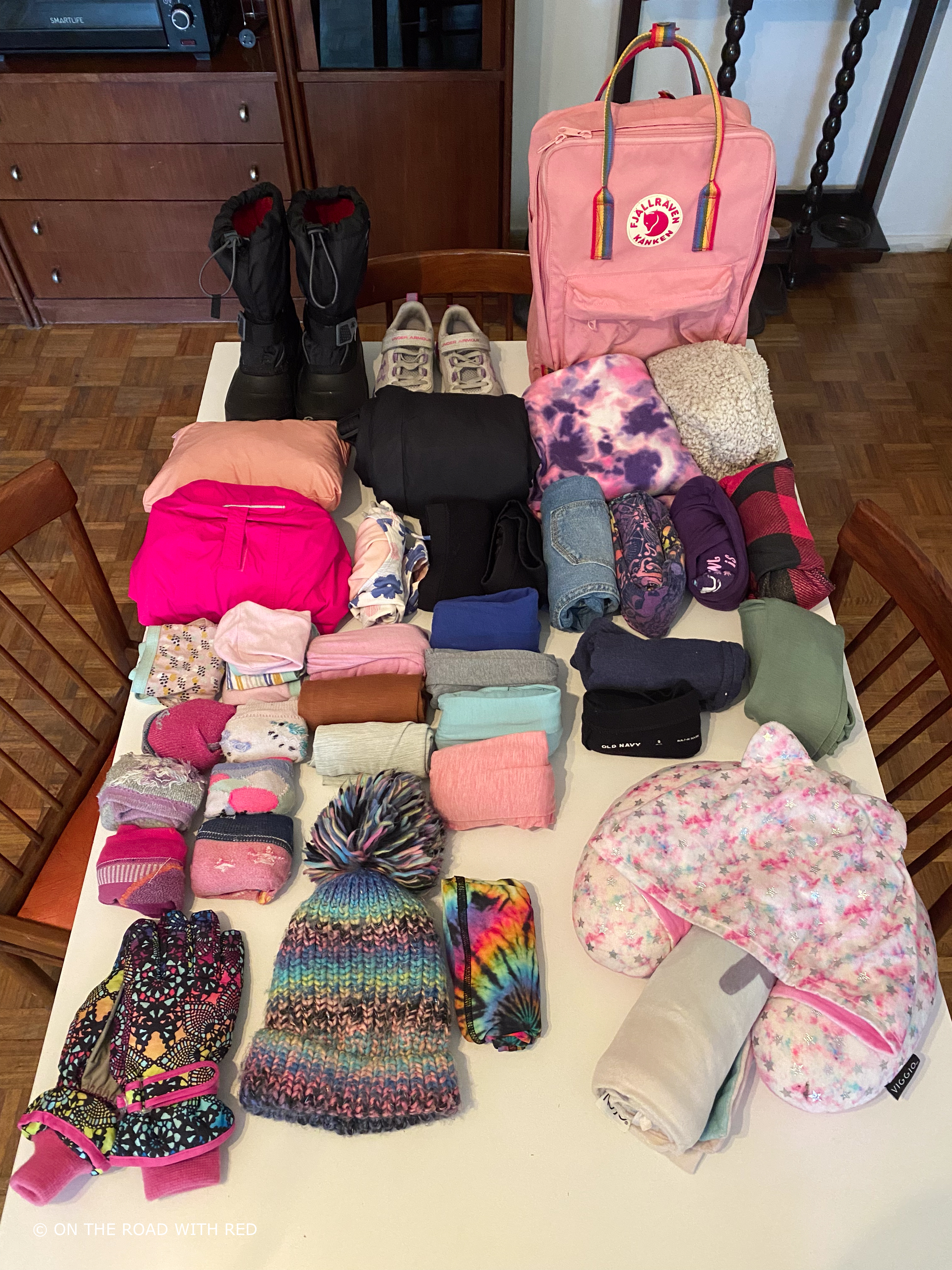
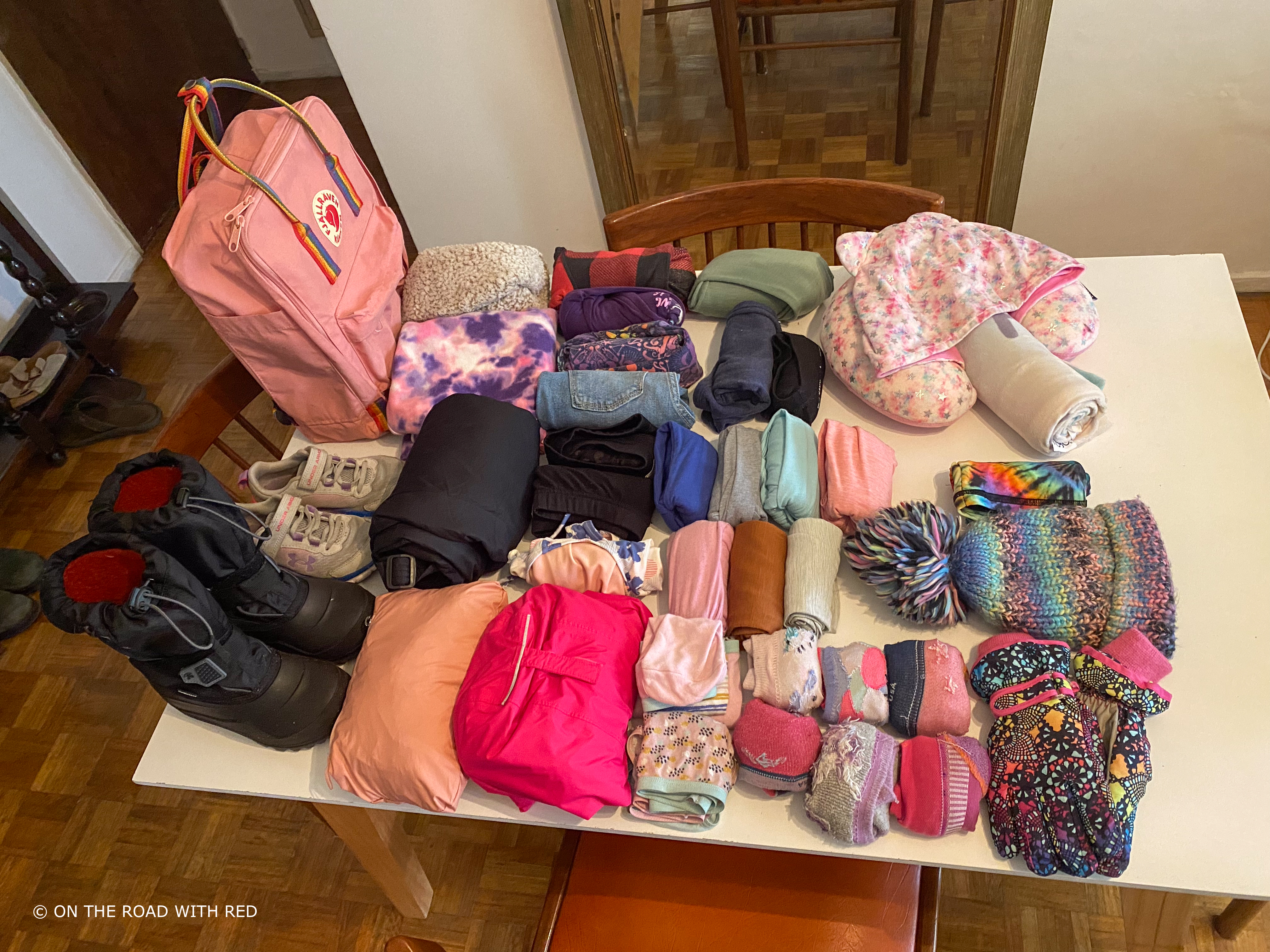
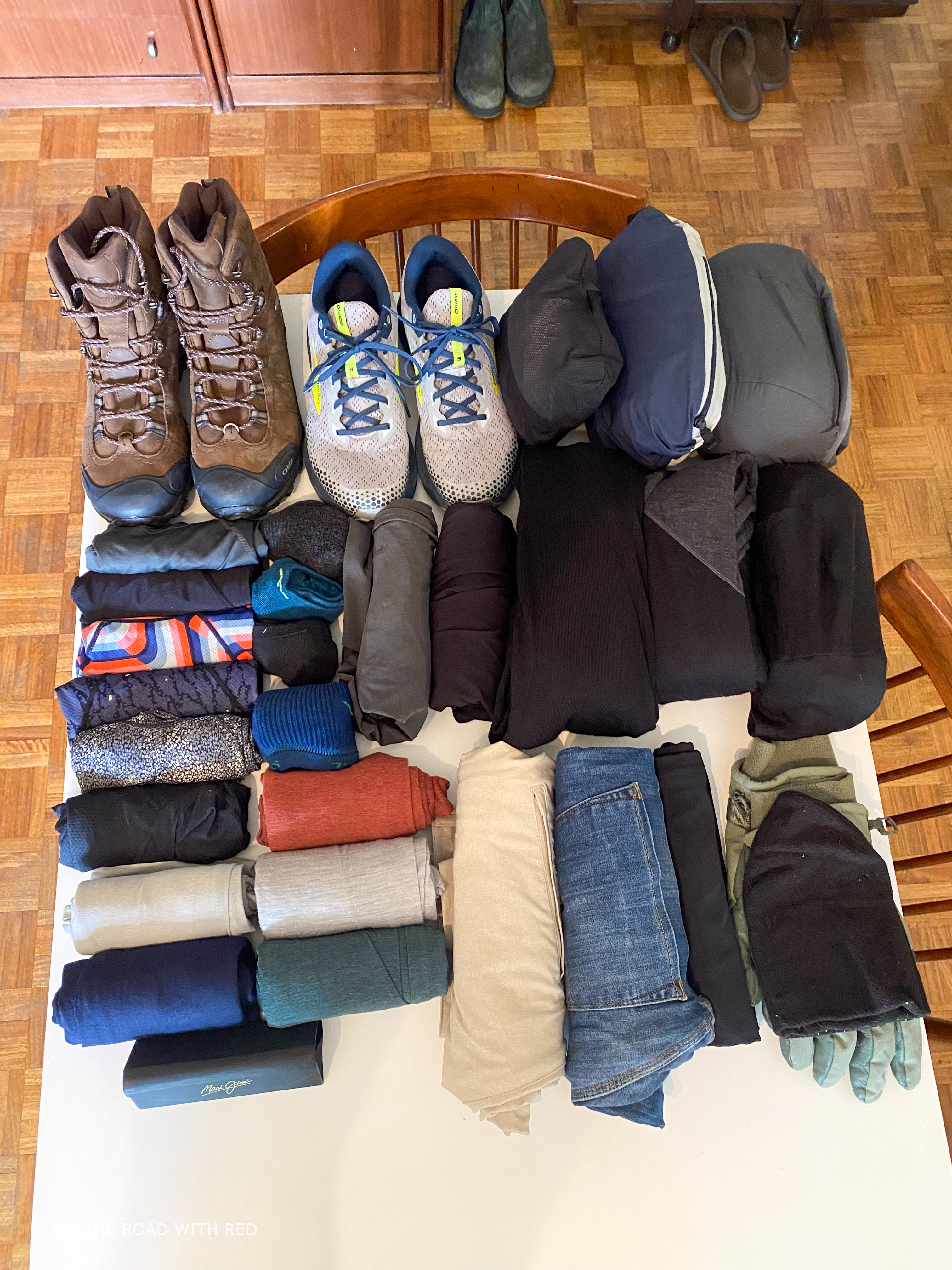
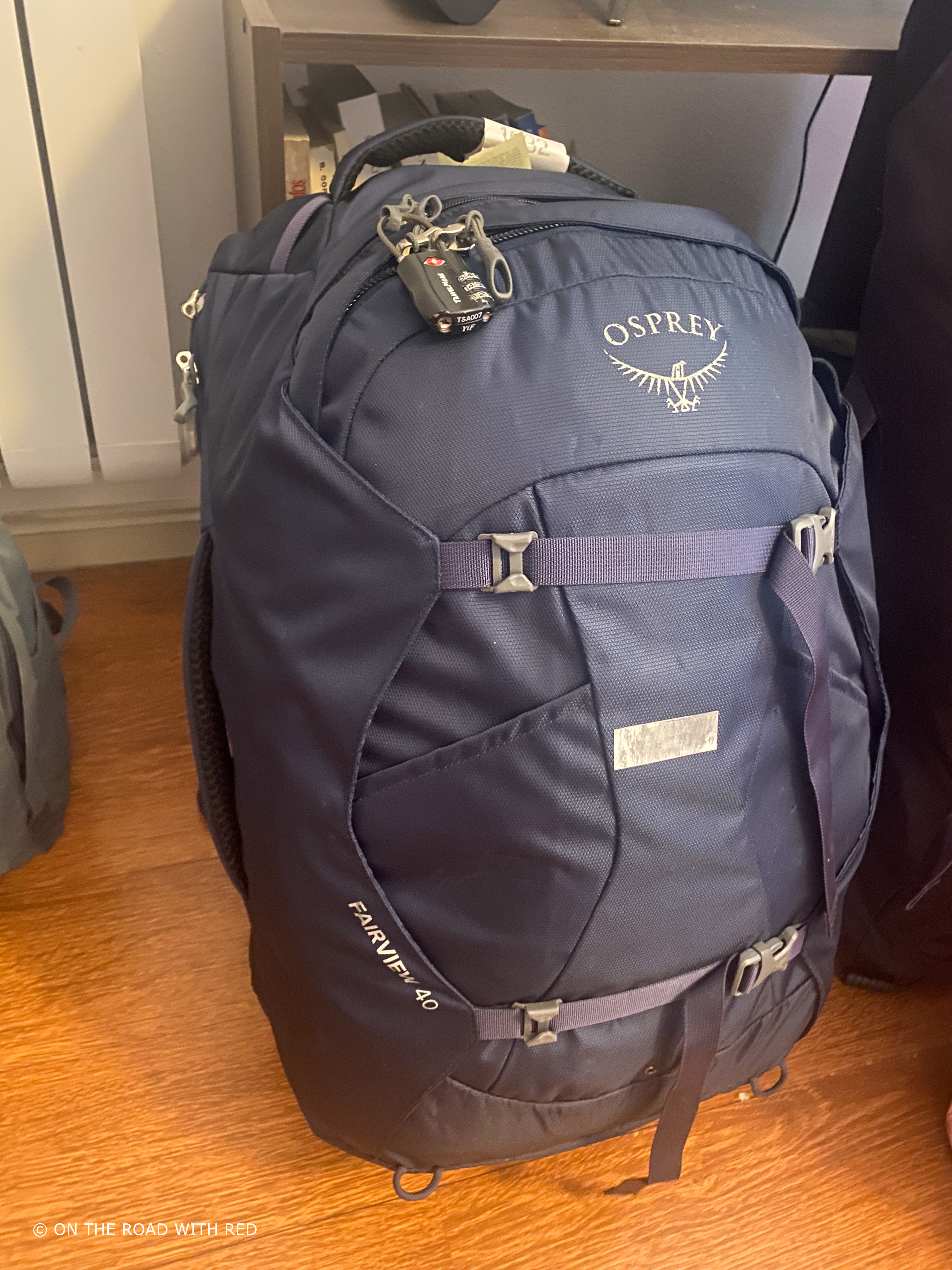
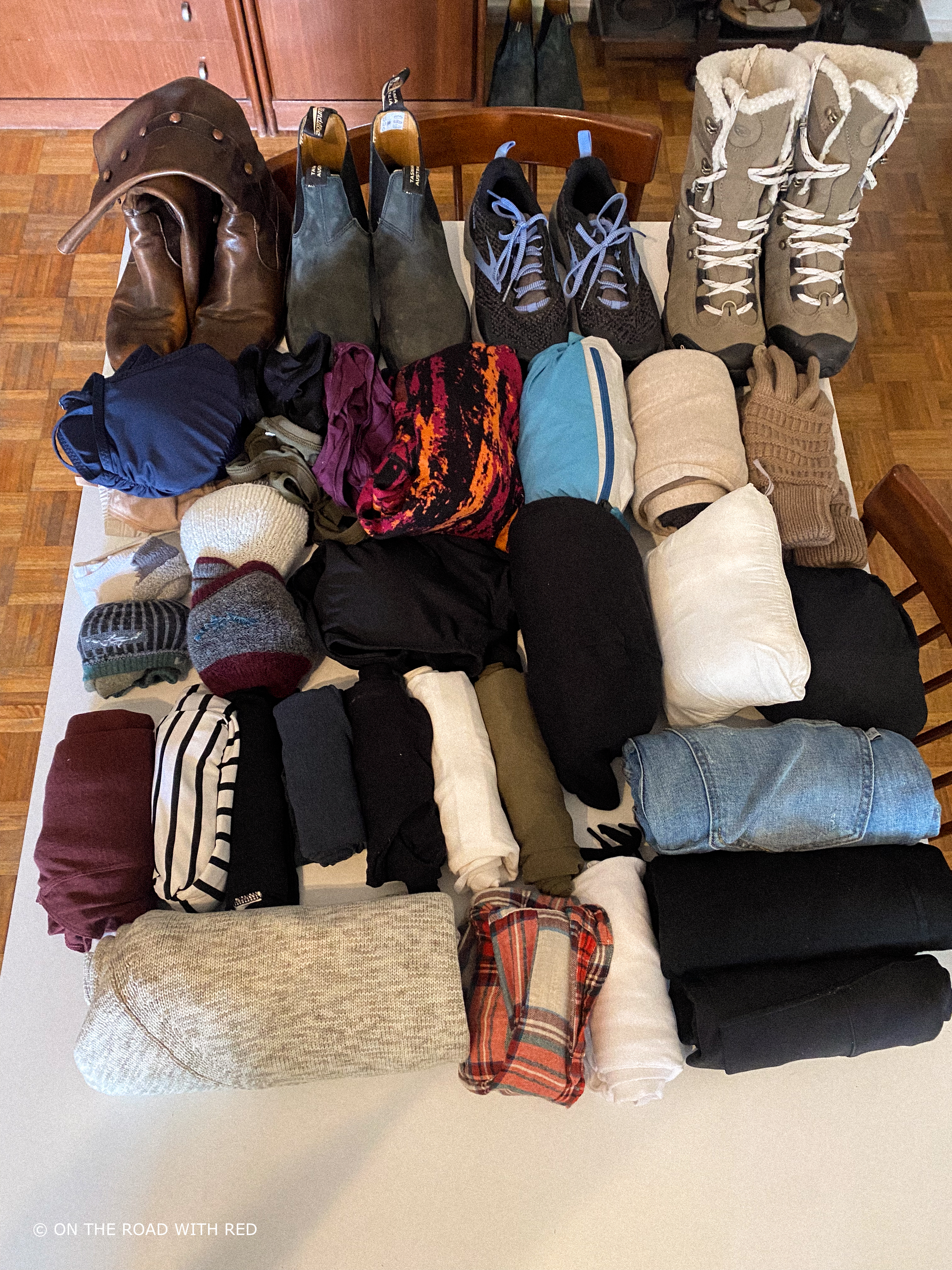
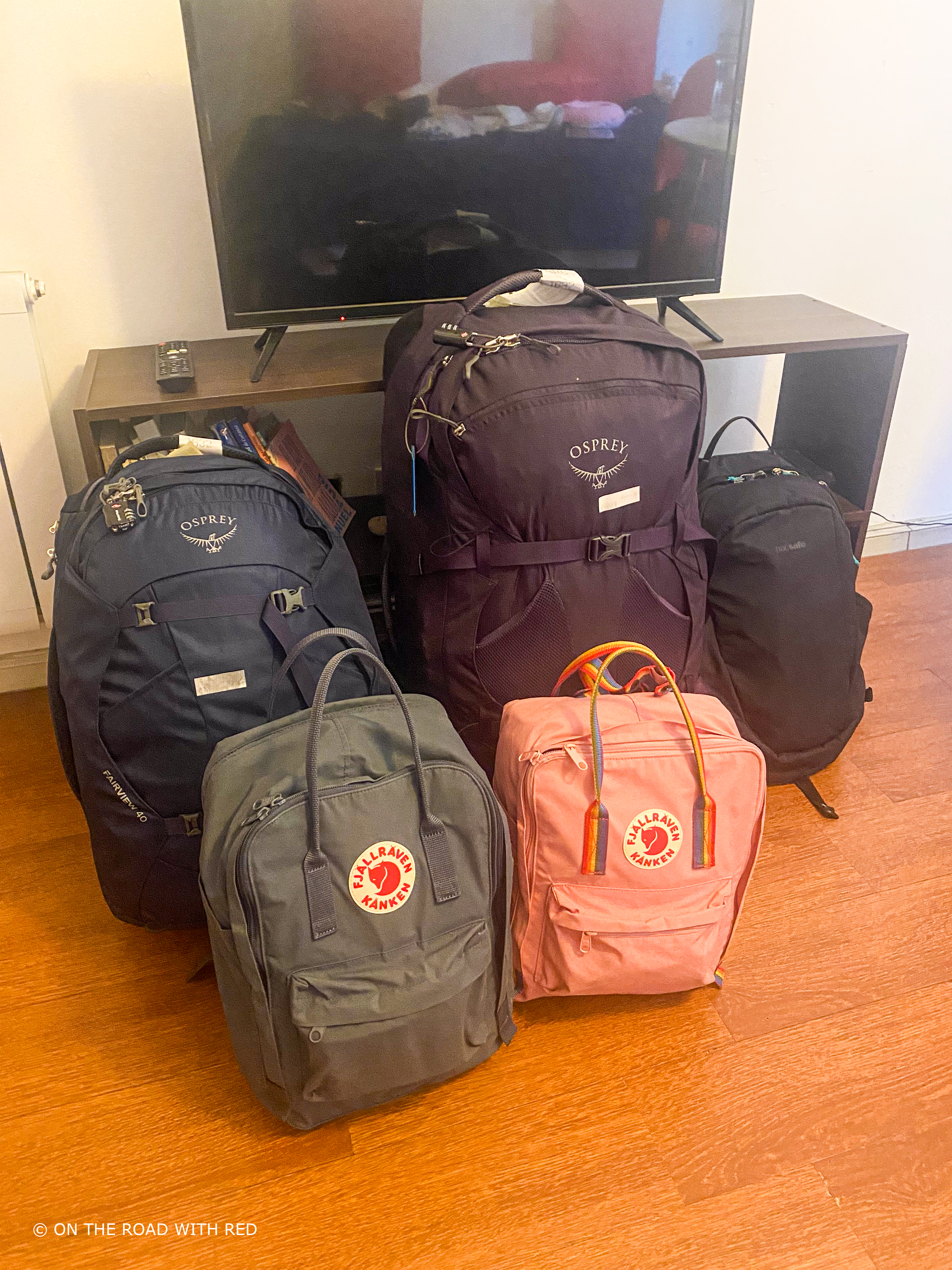
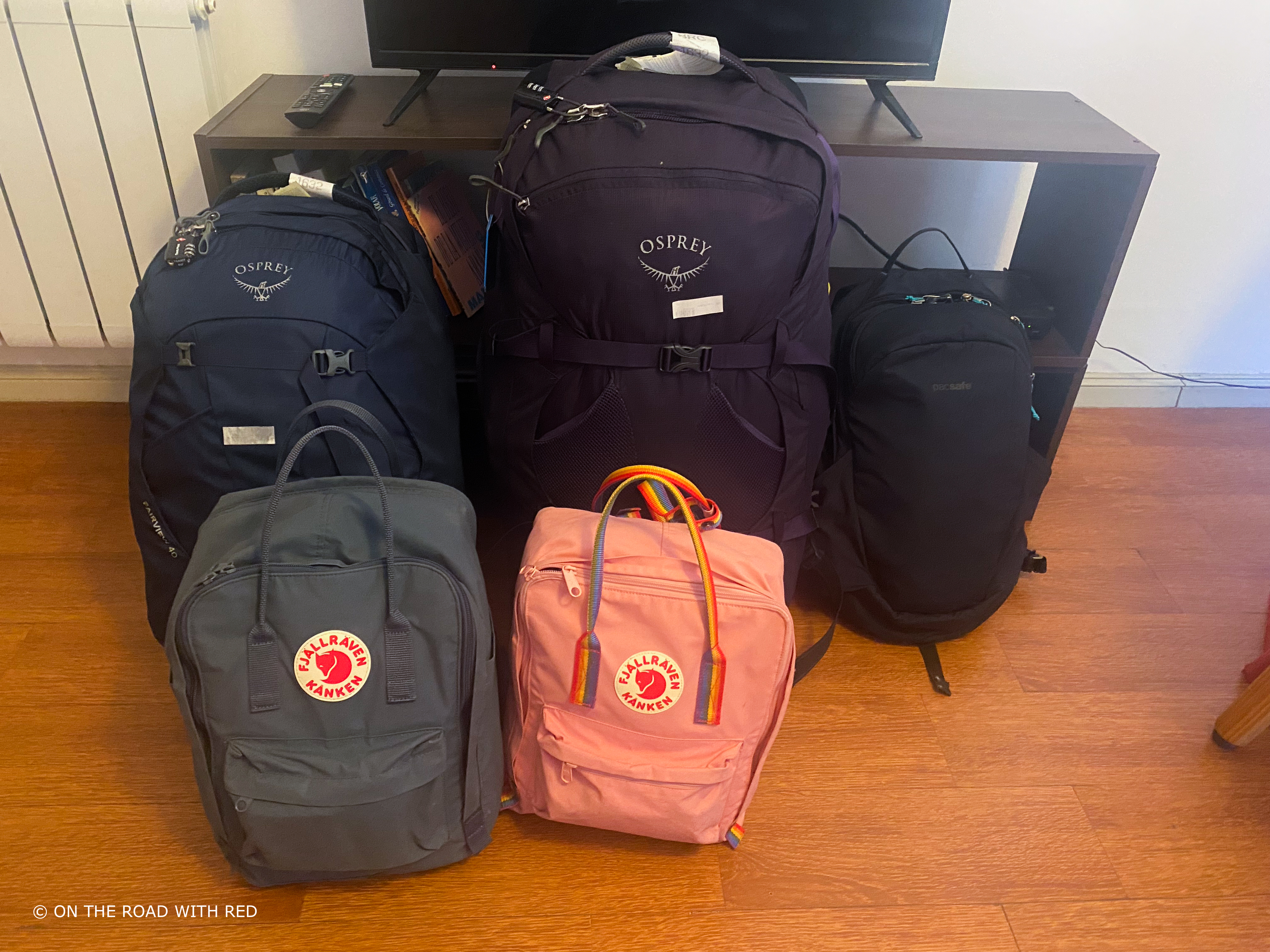
Sustainable Transportation
Traveling with children offers a world of wonder and learning opportunities. In our journey with “On the Road with Red,” we’ve discovered that choosing sustainable transportation is not just a travel choice but a teachable moment about environmental stewardship.
Embracing Public Transportation
Public transportation is a fantastic way for families to reduce their carbon footprint. Buses, trains, and trams are efficient ways to navigate new cities. They offer a real sense of the local life and are often an adventure in themselves for kids. We are working on becoming better at this. It is so much cheaper and better for the environment. The good news is we currently just walk most places. We are currently working to break our habit of grabbing a taxi when little legs get tired.
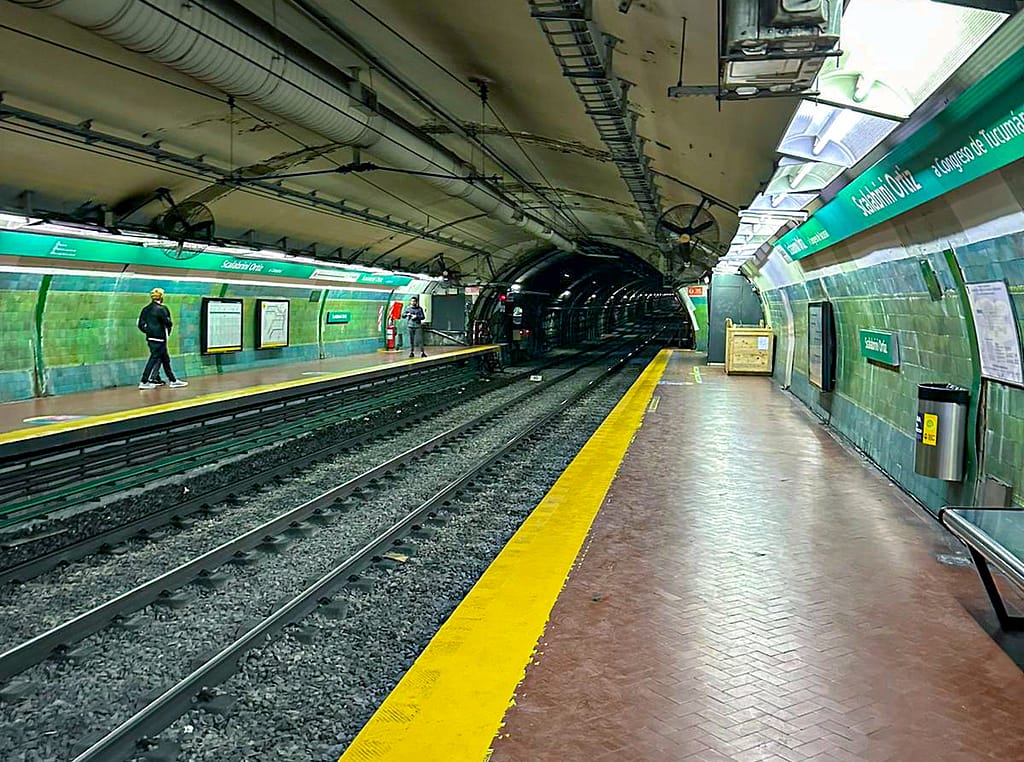
The Joy of Walking and Cycling
Walking and cycling are not only healthy and fun but also the most eco-friendly ways to explore. Many cities offer bike rental services with child seats or family bikes. Walking tours can also be a great way to delve into the nooks and crannies of a new place. This has been a huge switch-up for us. We walk everywhere now! Not having a vehicle has been wonderful.
Car Rentals – Opting for Green
When renting a car is necessary, opt for a hybrid or electric vehicle. These cars have a lower environmental impact compared to traditional gasoline vehicles. They’re quiet, efficient, and a great way to teach kids about alternative energy sources.
Flying Less, Exploring More
Air travel is a significant contributor to carbon emissions. We try to plan trips that require less flying and more ground exploration. When flights are unavoidable, consider direct routes and look into airlines that offer carbon offset programs.
The Benefits of Slow Travel
Slow travel is about reducing the rush and taking time to immerse in the destinations. It often involves using more sustainable modes of transport like trains or boats. This approach not only benefits the environment but also allows families to have a deeper connection with the places they visit. This is our specialty! If someone suggests 4 days for a destination, we are staying 2 weeks. We do not like the rush. We are focused on the immersion. So much so that our planned one-month in Buenos Aires has turned into renting an apartment and it becoming our base while we tour South America.
Educating Through Experience
Using sustainable transportation is an educational experience for children. It’s a practical way to teach them about energy use, carbon footprint, and the importance of making environmentally responsible choices.
As a family that travels the world, we recognize the importance of sustainable transportation. It’s a core part of our travel philosophy – to explore the world responsibly and leave a positive impact. By choosing eco-friendly transportation options, we can show our children how to care for our planet while discovering its many wonders.
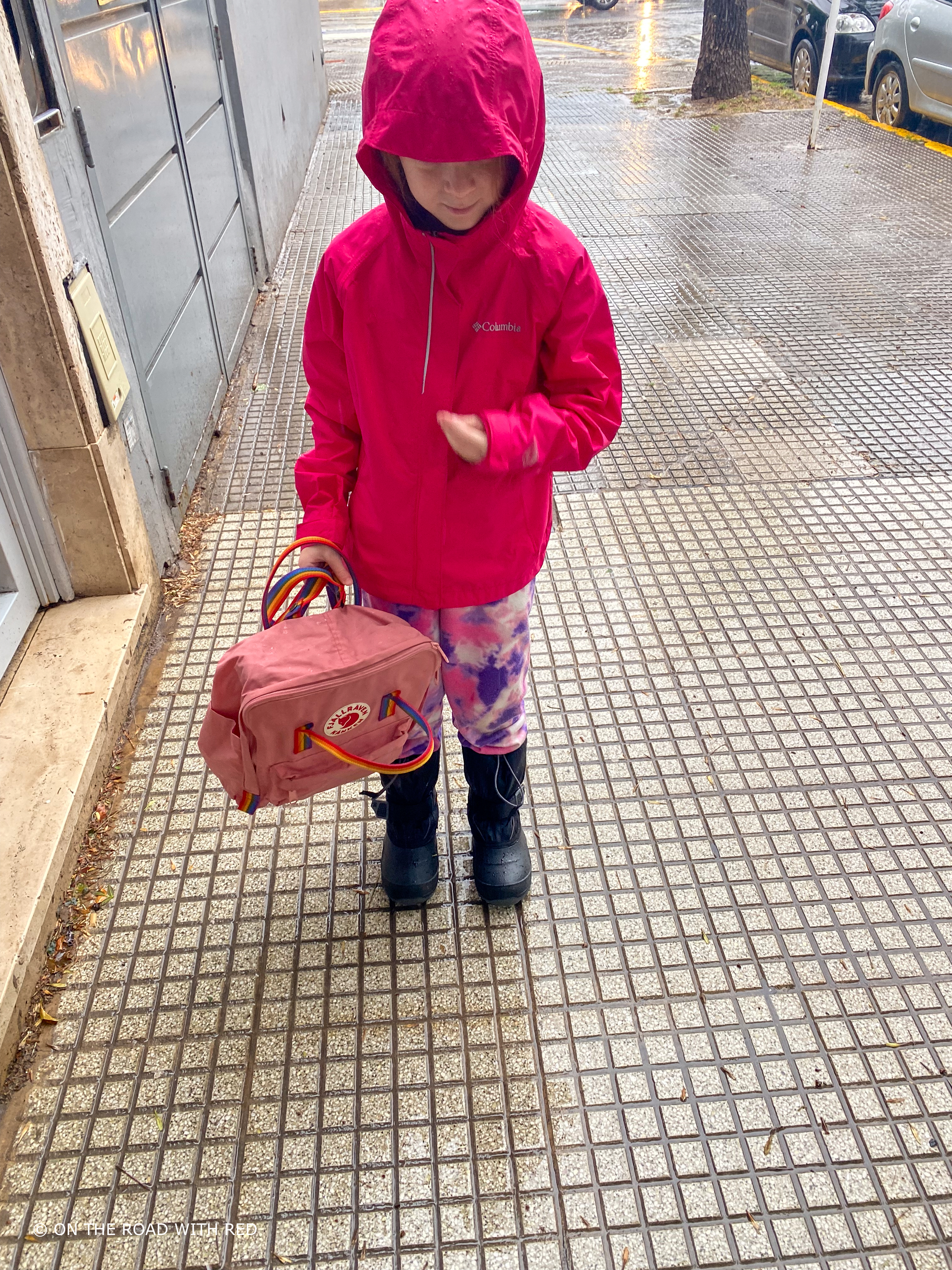
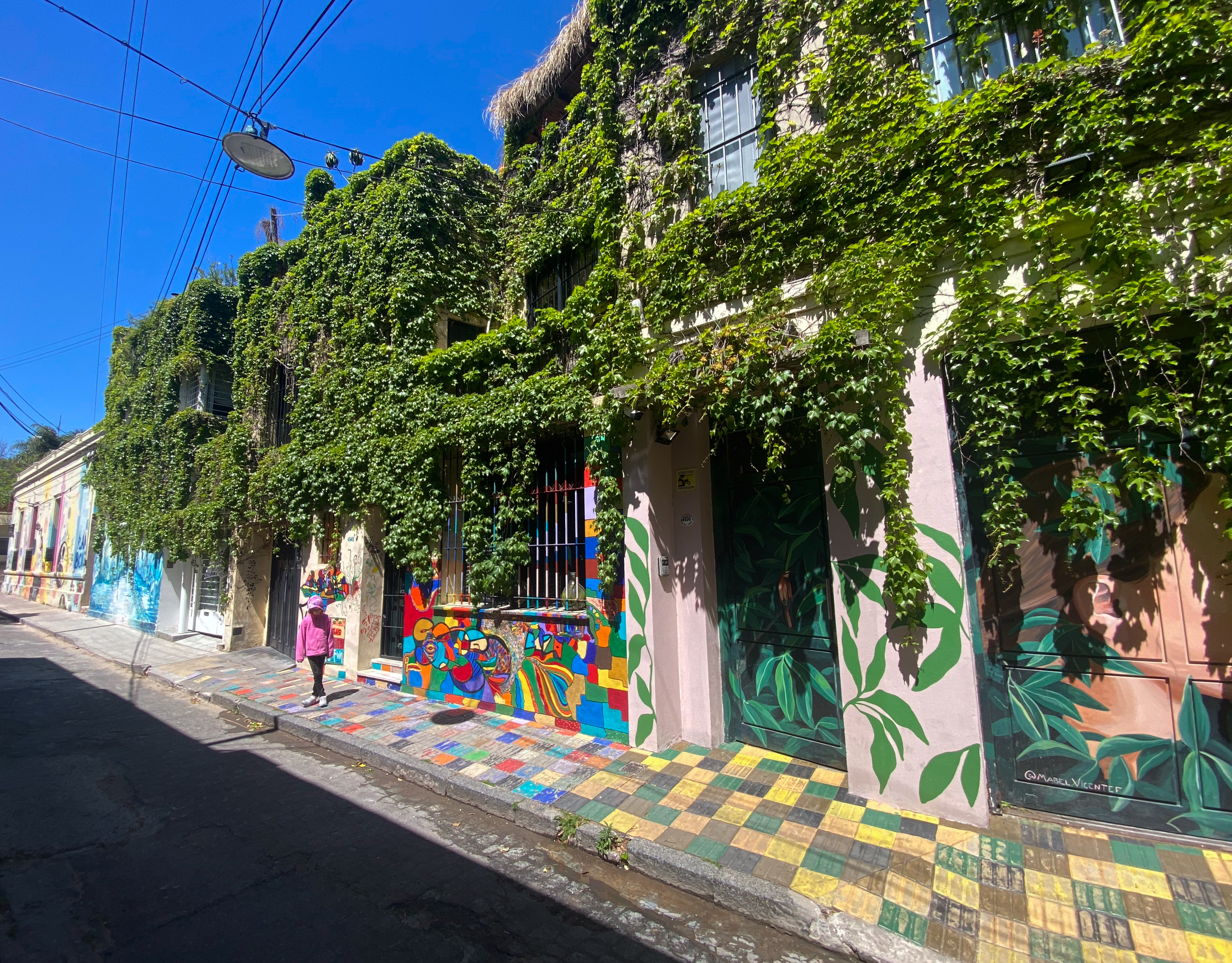
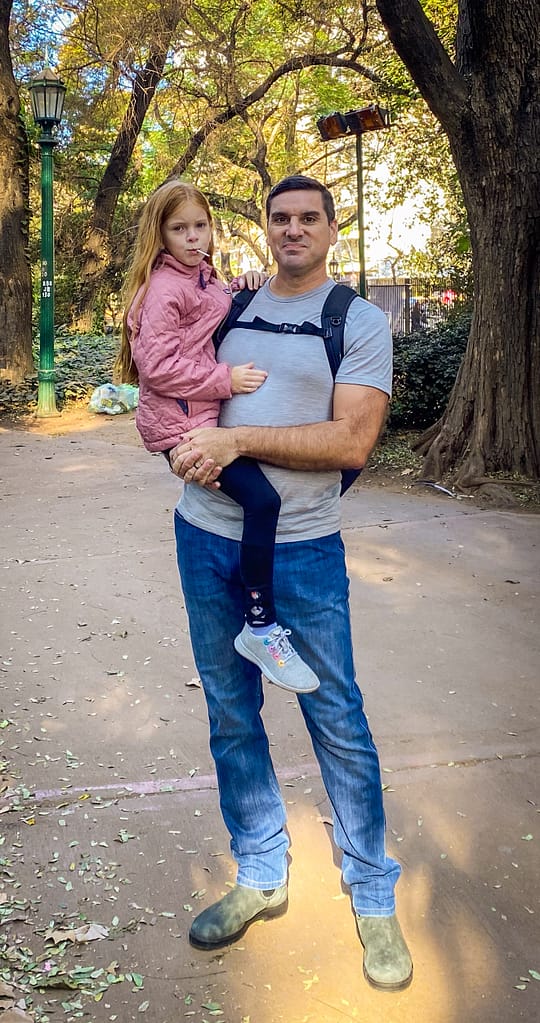

Engage your children in practicing the 5 R’s (Reduce, Reuse, Recycle, Repurpose, and Refuse)
- Reduce: Minimize waste by avoiding single-use plastics and disposable items.
- Reuse: Bring reusable shopping bags, water bottles, and food containers.
- Recycle: Teach your children to identify recycling bins and to separate recyclables.
- Repurpose: Get creative with items you have on hand, turning them into art or useful items.
- Refuse: Politely decline single-use items like straws or plastic cutlery when dining out.
Support Local and Sustainable Food
When traveling with children, one of the most enriching and responsible choices we can make is to support local and sustainable food sources. At “On the Road with Red,” we’ve discovered that this approach not only enhances our travel experience but also contributes positively to the communities we visit.
The Importance of Eating Local
Eating local is about more than just enjoying fresh flavors. It’s about connecting with the culture and community of the place we’re visiting. Local food is often grown using traditional methods that are better for the environment. It also reduces the carbon footprint associated with transporting food over long distances.
Discovering Farmers’ Markets and Local Eateries
One of the best ways to support local food is by visiting farmers’ markets. Here, families can find a variety of fresh, locally-grown produce and handmade goods. Local eateries, as opposed to chain restaurants, often source their ingredients from nearby farms, offering authentic and sustainable dining options. We love farmer’s markets! We are lucky enough to currently have two each weekend within a few blocks of our apartment. This is where we get all of our fruits and vegetables for the week.
The Educational Aspect for Children
Introducing children to local foods can be an educational adventure. It allows them to learn about different cultures and the importance of sustainable living. Tasting new flavors and dishes can also be a fun way to encourage them to be more adventurous with their food choices. It has been very exciting to watch our very picky eater start expanding her horizons when it comes to food. Cultural immersion has been very beneficial for this. When children see other children eating a certain food it magically becomes appetizing.
Sustainable Seafood: A Responsible Choice
When traveling to coastal areas, choosing sustainable seafood is crucial. This means opting for fish that are plentiful and fished or farmed in environmentally friendly ways. It’s a responsible choice that helps preserve marine life and ecosystems. I highly recommend watching Seaspiracy for more information.
Participating in Cooking Classes and Food Tours
Participating in local cooking classes or food tours can be a delightful experience for families. These activities offer insight into local cuisine and cooking techniques, making for a memorable and educational experience.
The Impact on Local Communities
By choosing local and sustainable food options, travelers can have a positive impact on the local economy. It supports small farmers and business owners, contributing to the community’s well-being.
Incorporating local and sustainable food into our travel choices is a rewarding way to explore new cultures, benefit local communities, and teach our children about responsible living. It’s a tasteful journey towards a more sustainable future, one plate at a time.
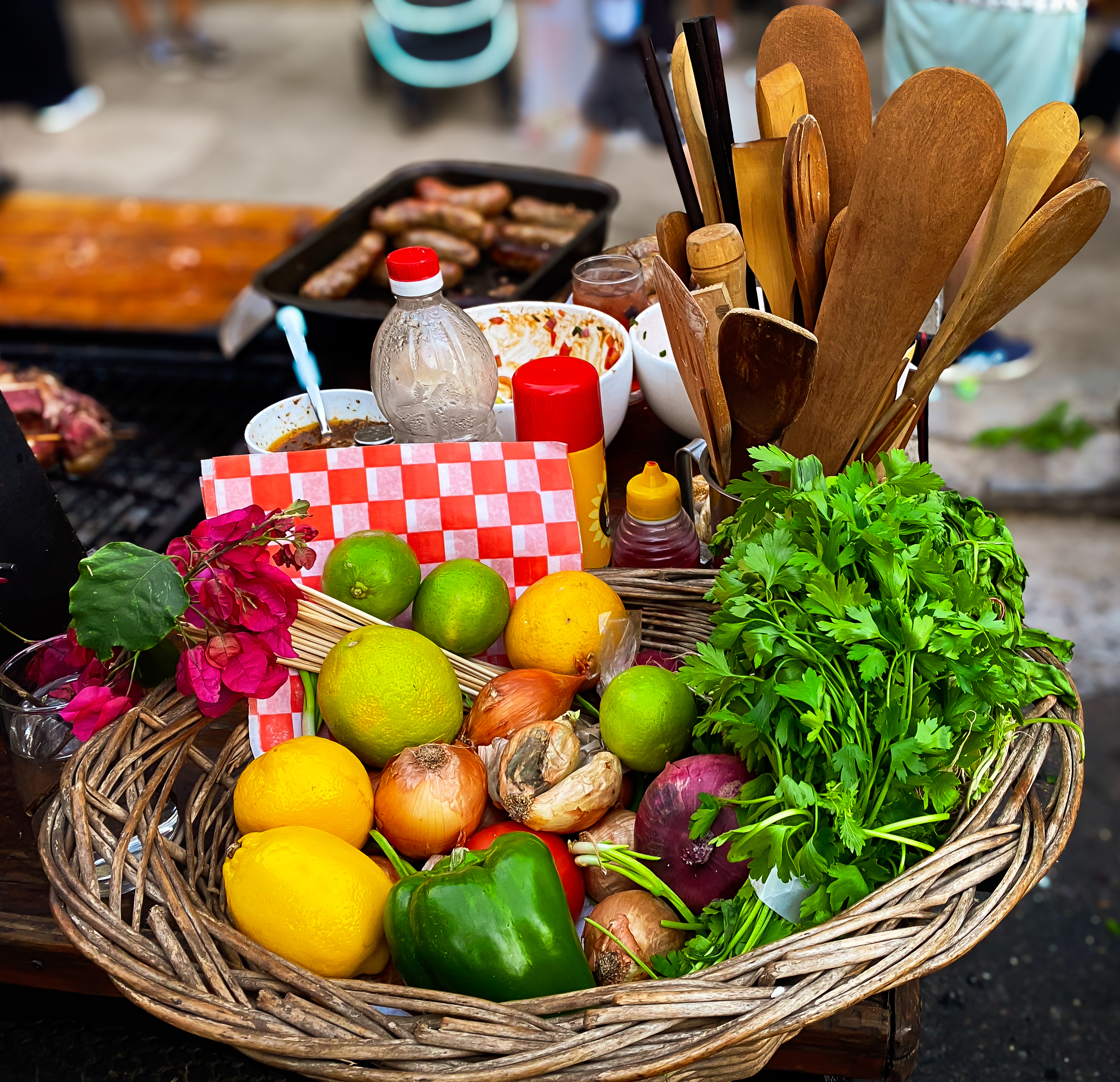








Learn About Local Ecosystems
Traveling with children presents a unique opportunity to explore and learn about local ecosystems. At “On the Road with Red,” we’ve found that understanding the natural environments of the places we visit deepens our travel experience and fosters a sense of responsibility towards the planet. This is one of our favorite things. My goal at each destination is to see the local wildlife in the wild! Or in the case of Brazil, the wild Marmosets coming into our kitchen!

The Joy of Exploring Local Ecosystems
Each destination has its unique natural environment. Whether it’s the rainforests of Costa Rica, the coral reefs of Australia, or the mountain ranges of Nepal, exploring these ecosystems can be both exciting and educational for families. It offers a chance to see wildlife in their natural habitats and understand the delicate balance of nature.
Why Learning About Ecosystems Matters
Understanding local ecosystems is crucial in appreciating the importance of conservation efforts. It helps children and adults alike grasp the impact of human activities on the environment. This knowledge can inspire sustainable practices, both while traveling and at home.
How to Learn About Local Ecosystems
- Guided Tours and Nature Walks: Participating in guided tours led by knowledgeable locals or naturalists can be an enriching experience. These experts can provide valuable insights into the local flora and fauna and the challenges they face.
- Visiting National Parks and Reserves: Protected areas are great for observing ecosystems in their natural state. Many parks offer educational programs for children, making it a fun learning experience.
- Participating in Conservation Projects: In some destinations, families can take part in conservation projects. This hands-on approach is an excellent way for children to learn about environmental protection.
- Educational Resources: Utilizing books and online resources about the destination’s ecosystem before the trip can enhance the learning experience. It prepares the family for what they might encounter and deepens their understanding.
The Benefits of Eco-Educational Travel
Learning about local ecosystems while traveling can significantly impact children’s perspectives on the environment. It encourages them to be more conscious of their actions and promotes a lifelong interest in nature and conservation.
Exploring and learning about local ecosystems is a vital component of sustainable travel with children. It’s not just about seeing new places; it’s about understanding and respecting the natural world. Such experiences can shape young minds, fostering a generation of environmentally conscious travelers. For example, during our time in Brazil, we did a tour that included visiting an eco-park and learning about local cultures and wildlife. We visited a local and sustainable shrimp farm. We were able to see local sea turtles in the wild.

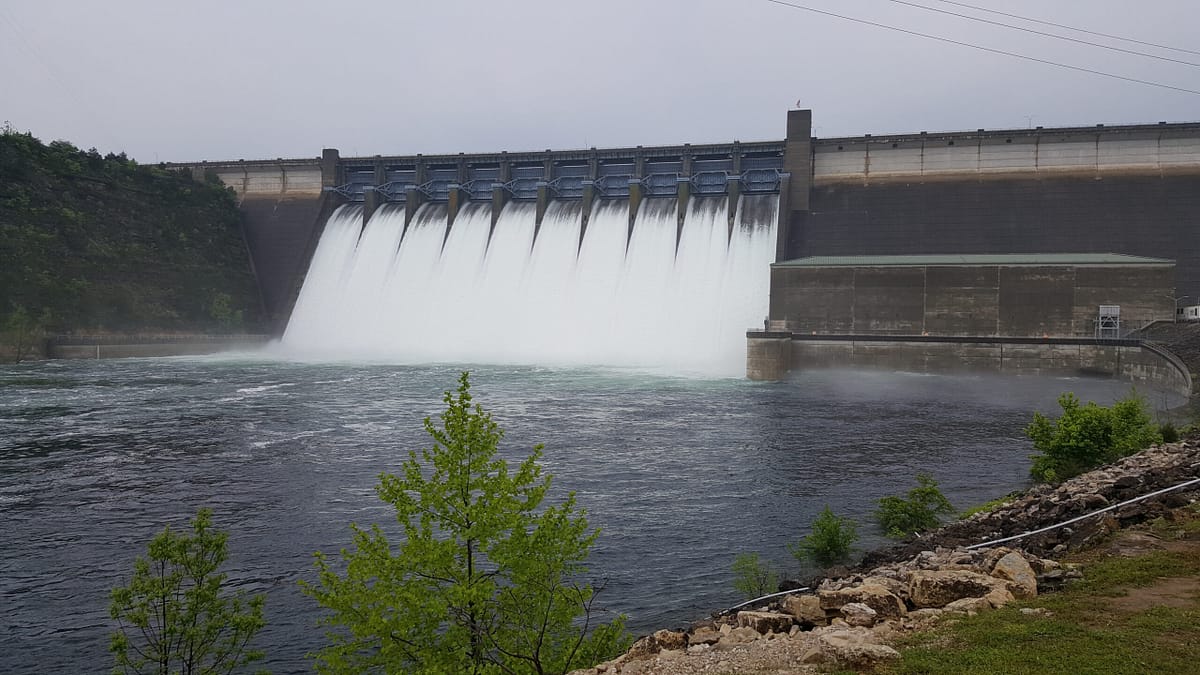
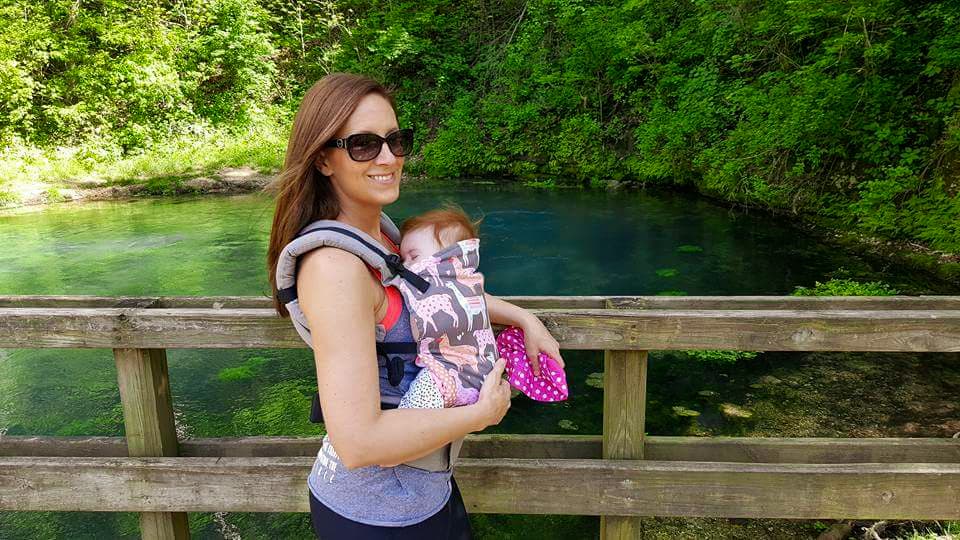
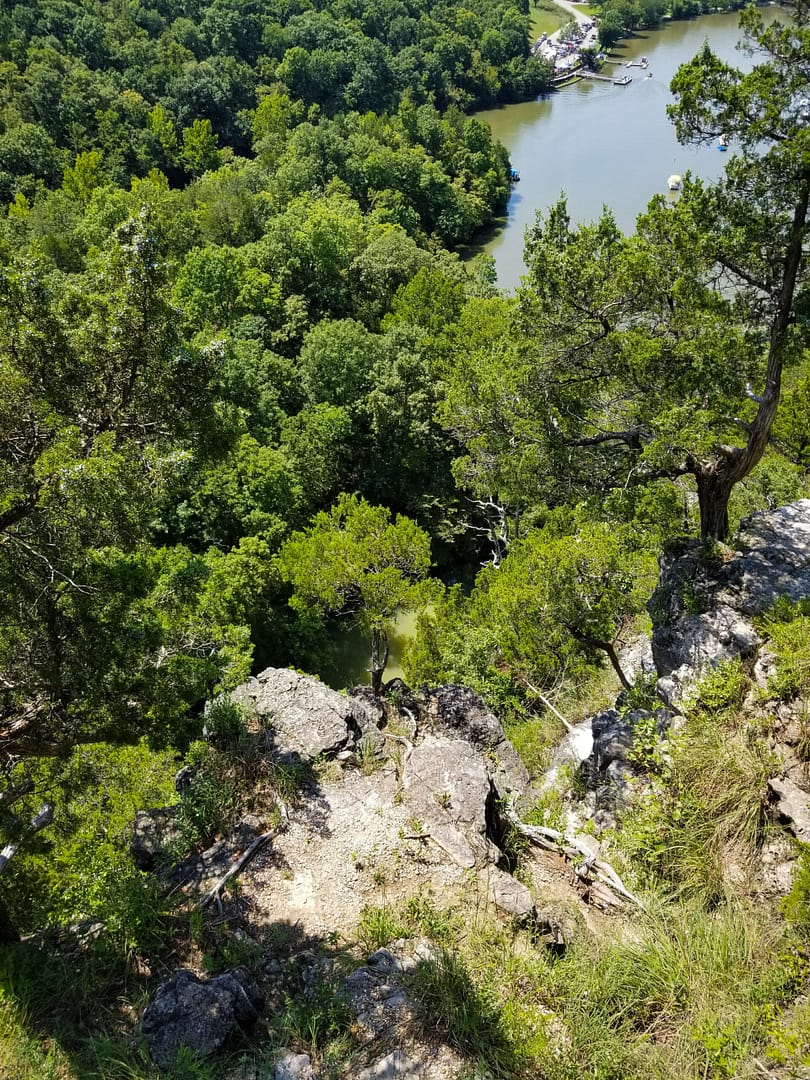
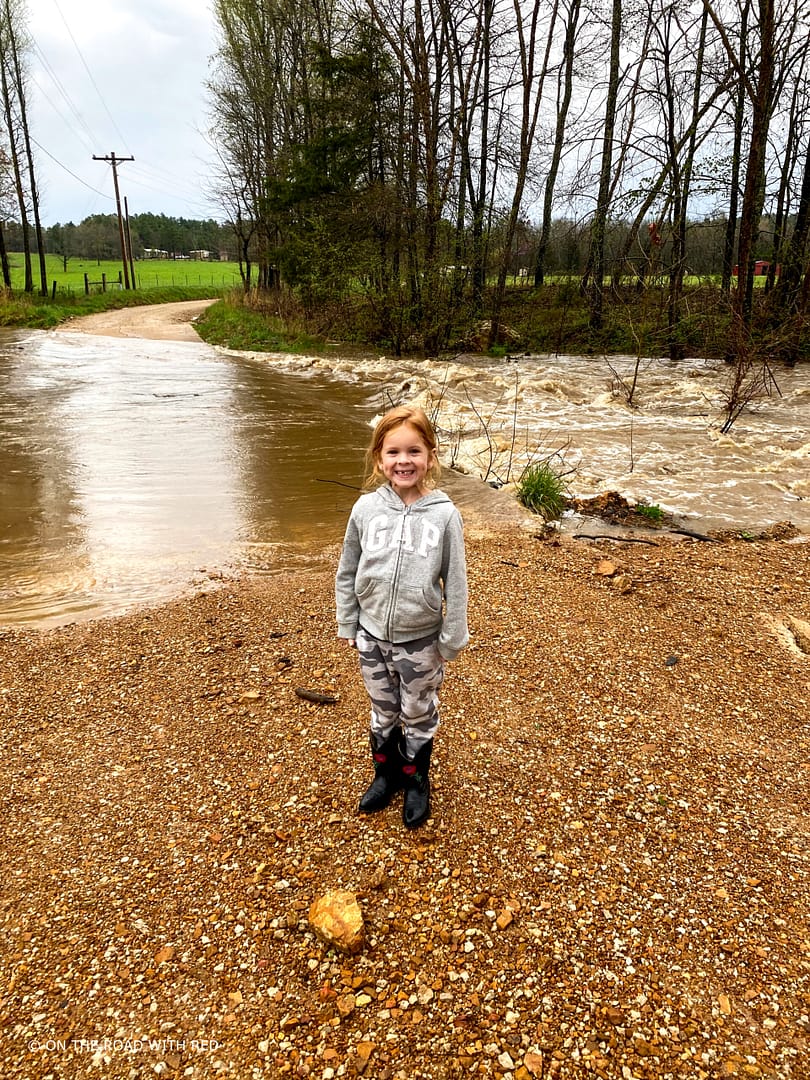
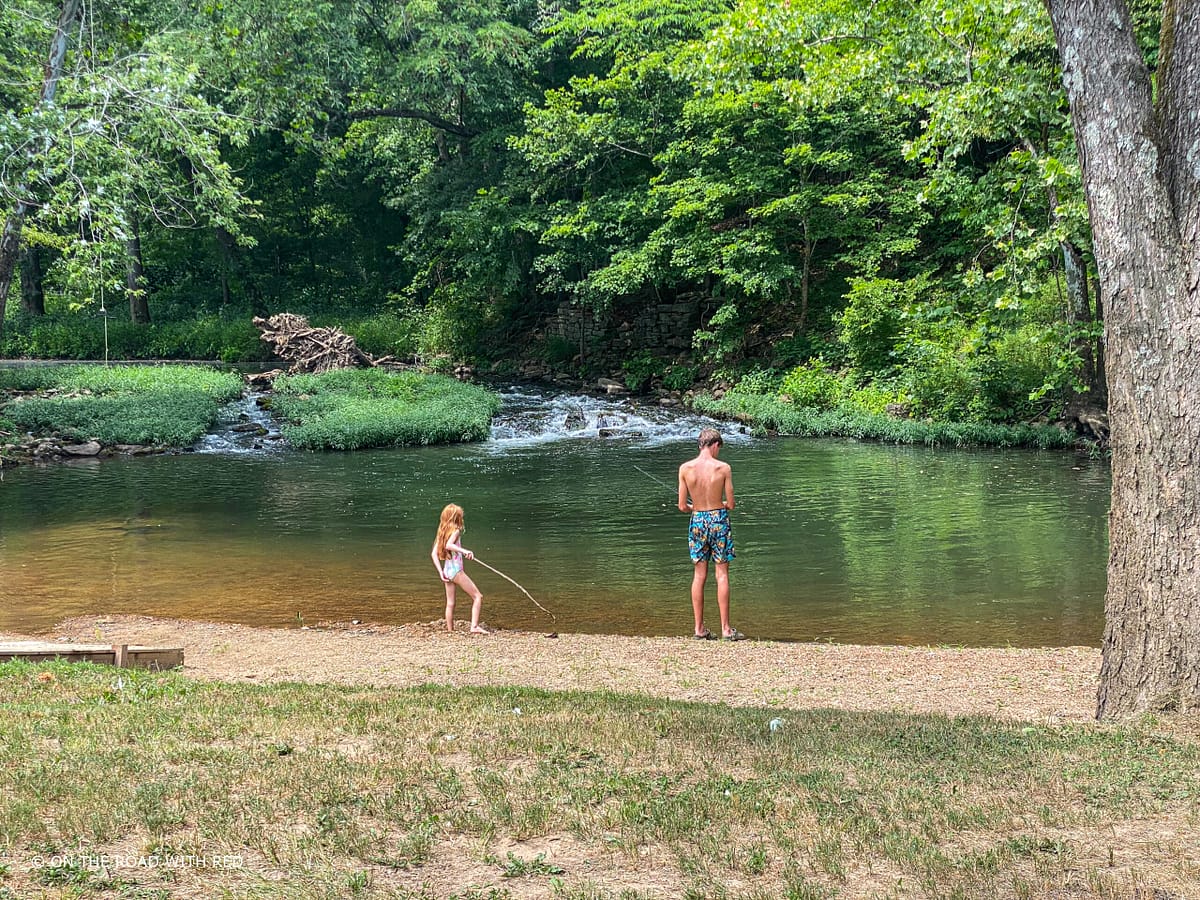
Leave No Trace
Traveling with children is an opportunity to instill values that they will carry for a lifetime. Among these, the Leave No Trace principles stand out as a cornerstone for sustainable travel. At “On the Road with Red,” we believe in empowering our children with the knowledge and practices that support environmental stewardship.
Understanding Leave No Trace
Leave No Trace refers to a set of seven principles designed to minimize our impact on the environment. These principles guide us on how to interact with nature responsibly, ensuring we preserve it for future generations.
The Seven Principles Simplified for Kids
- Plan and Prepare: Teach children the importance of planning, which helps avoid damaging nature.
- Travel and Camp on Durable Surfaces: Stick to trails and campsites to protect undergrowth and wildlife habitats.
- Dispose of Waste Properly: Pack out trash and teach kids about proper waste disposal.
- Leave What You Find: Encourage children to observe but not disturb natural and cultural artifacts.
- Minimize Campfire Impacts: Use established fire rings and keep fires small.
- Respect Wildlife: Observe animals from a distance and avoid feeding them.
- Be Considerate of Other Visitors: Share the trails and natural spaces respectfully.
Incorporating the Principles in Travel
Incorporating Leave No Trace into family travel doesn’t have to be complicated. It can be as simple as carrying reusable water bottles, avoiding single-use plastics, or ensuring you leave a picnic spot cleaner than you found it. We are huge supporters of beach clean up.
Educational Activities for Kids
Engaging children in games and activities that reinforce these principles can be effective. For example, a nature scavenger hunt where children look for specific natural features without disturbing them, or a game that involves identifying animal tracks.
The Broader Impact of Leave No Trace
Teaching children about Leave No Trace goes beyond preserving the environment. It fosters a sense of responsibility, respect for nature, and an understanding of the delicate balance of ecosystems.
Embracing the Leave No Trace principles during family travels is a powerful way to contribute to environmental preservation. It teaches children to respect nature, ensuring they grow up to be conscientious travelers and caretakers of our planet. By adopting these practices, we can all enjoy the beauty of the world today while safeguarding it for tomorrow.
Encourage Mindful Consumption
When it comes to traveling with children, one of the most significant lessons we can impart is the practice of mindful consumption. In our journey with “On the Road with Red,” we have come to realize that the choices we make in what and how we consume can leave a lasting imprint on the places we visit and on the planet as a whole.
Understanding Mindful Consumption
Mindful consumption is about being aware of the impact our consumption has on the environment, societies, and economies. It involves making choices that are both environmentally and socially responsible.
Why Mindful Consumption Matters in Travel
Travel often increases our consumption patterns. This is something I quickly noticed as we began full-time travel. When we had been based in one location longer, we were so conscious about waste and consumption. The stress and change of transitioning to full-time travel can make keeping up with normal patterns more difficult. However, by being mindful, we can reduce waste, support local economies, and minimize our environmental impact. Don’t get down on yourself if you notice yourself slip a bit. Take the opportunity to regroup, learn from it, and find a new solution. This approach is crucial in teaching children about sustainability and responsible living.
Tips for Practicing Mindful Consumption on the Road
- Choose Sustainable Products: Opt for products that are eco-friendly and sustainably sourced. This includes items like biodegradable toiletries, reusable water bottles, and eco-friendly sunscreens. When we travel we always have our LIfestraw Plus collapsable water bottles.
- Reduce Plastic Usage: Avoid single-use plastics by carrying reusable bags, bottles, and containers. Educate children on the impact of plastic on the environment.
- Support Local Artisans and Businesses: Purchase souvenirs and goods from local artisans and businesses. This not only contributes to the local economy but also reduces the carbon footprint associated with long-distance shipping. We don’t buy many things, but I do love my mate gourd from Fabrica de Mate in Buenos Aires.
- Be Food Conscious: Choose local and organic food options. Eating local reduces transportation emissions and supports local farmers.
- Minimize Waste: Teach children the importance of minimizing waste. This includes avoiding unnecessary packaging and being conscious of food waste.
- Travel Light: Encourage packing light to reduce fuel consumption in travel. This also makes the travel experience more enjoyable and less encumbered. I seriously obsess about this. I determined to pack less and less. We are getting there.


Long-Term Benefits for Children
Teaching children about mindful consumption during travel can have long-lasting effects. It instills in them an understanding of their impact on the world and the importance of making sustainable choices. These lessons go beyond travel and become part of their everyday life decisions.
Mindful consumption is a key component of sustainable travel, especially when journeying with children. It’s about making conscious choices that respect and preserve the natural and cultural environments we explore. By adopting these practices, we can ensure that the wonders of the world will be there for future generations to enjoy.
Document and Share the Journey
Capture your eco-conscious adventures and share them with your children through photos, journals, or blogs. Encourage them to reflect on the lessons learned and the importance of protecting the planet’s resources for future generations. This was our beginning thought process for documenting our journeys. We want to leave a legacy for our family that can be passed on for generations.
Traveling sustainably and minimally with children can be a transformative experience that not only deepens your family connections but also instills a lifelong commitment to environmental stewardship. By exploring the world responsibly and minimizing your impact, you can create cherished memories while teaching your children valuable lessons about protecting our planet’s precious resources. Together, your family can be part of a global movement toward a more sustainable and eco-conscious future in travel with children.
Last Updated on December 8, 2023 by On the Road with Red



